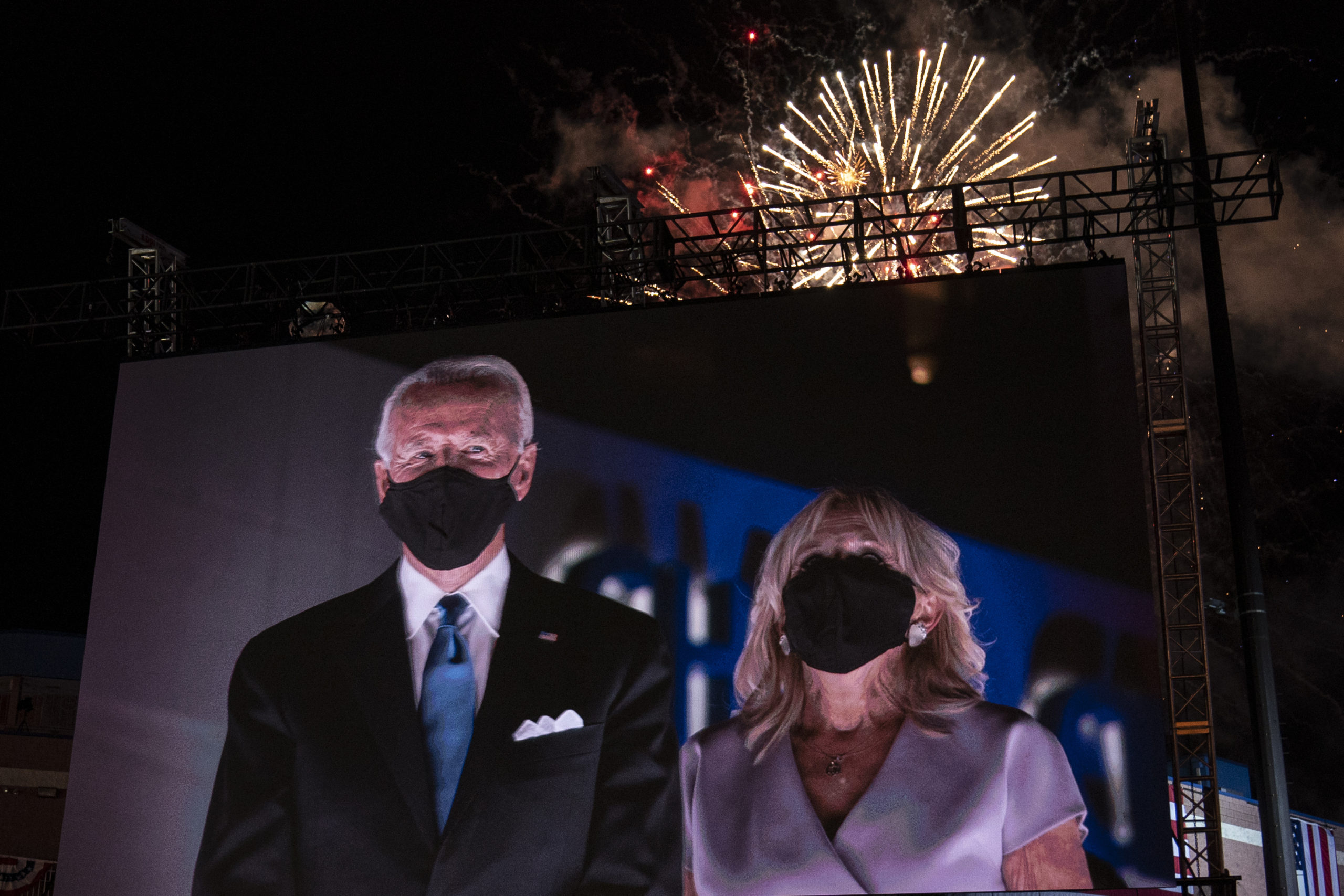In a near-empty arena on the river in his hometown, Joe Biden accepted the Democratic nomination for president, promising hope over fear, fairness over privilege, love over hate.
And, he said, “Facts over fiction.”
Let’s see about that.
Here are claims made by Biden, fact-checked or put in context.
“Five million Americans infected with COVID-19.”
It’s a little higher than that. According to data from Johns Hopkins University, the number of positive tests as of Aug. 20 was 5,573,517.
“More than 170,000 Americans have died.”
This is accurate. Johns Hopkins data counted 174,248 U.S. deaths through Aug. 20.
“More than 50 million people have filed for unemployment this year.”
This, too, is accurate. Since March 21, 57.4 million Americans have filed initial unemployment claims.
“By far the worst performance of any nation on Earth.”
The United States leads the world in the number of COVID-19 cases and deaths. Using other metrics that account for population, the U.S. isn’t the absolute worst, but it still lags behind many other countries. For instance, the United States has the fifth-highest deaths per 100,000 people.
The virus is known to have infected a higher percentage of the population in the U.S. than in many other places. The U.S. has one of the highest rates globally of people who have tested positive — 16,430 per million residents, which is lower than Chile, but higher than any other large country.
“More than 10 million people are going to lose their health insurance this year.”
This number may be an underestimate. In a July report, the Urban Institute estimated that from April through December 2020, 10.1 million people will lose health insurance tied to a job that they lost during the pandemic. This analysis was done by looking at employment loss projections data from U.S. Labor Department reports.
But that number is lower than another estimate. The Kaiser Family Foundation estimates that nearly 27 million people could lose their employer-sponsored health insurance and become uninsured due to the COVID-19 pandemic. (Kaiser Health News is an editorially independent program of the foundation). This 27-million figure includes both those who lost employer-sponsored insurance as well as dependents who may have been covered on the same plan. The estimate was based on assessing data from Labor Department unemployment claims and determining if workers were eligible for ACA insurance.
“Nearly one in six small businesses have closed this year.”
This is basically accurate about closures overall, but only a small fraction are considered permanent.
A U.S. Chamber of Commerce survey from late July found that 13% of small businesses were closed — but of those, only 1% were considered permanent closures, with the other 12% considered temporary. (That’s closer to one in eight.)
Separately, the survey found that 23% of small businesses reported having temporarily closed at some point. About half of those had reopened by late July. And despite the vast majority of small businesses remaining at least partly open, 65% were concerned about having to close their business if the pandemic worsens.
“Our economy is in tatters, with Black, Latino, Asian American, and Native American communities bearing the brunt of it.”
Since the pandemic hit, unemployment numbers have hit highs not seen since the Great Depression.
In July, the rate for Black Americans was the highest at 14.6%, followed by 12.9% for Hispanics and 12.2% for Asian Americans. As Biden suggested, the unemployment rate for whites was significantly lower than other groups, at 9.2%.
Comparable data is not available for Native Americans, but a related statistic, the proportion of the population that is working, shows a similar pattern. Data compiled by the Center for Indian Country Development at the Federal Reserve Bank of Minneapolis found that the employment-to-population ratio for Native Americans has consistently trailed both white and Black Americans since the pandemic.

Supportes cheer from their cars as Democratic presidential candidate former Vice President Joe Biden and his wife Jill Biden are seen on a huge monitor as fireworks light up the night sky on the fourth day of the Democratic National Convention, Thursday, Aug. 20, 2020, outside of the Chase Center in Wilmington, Del. (AP Photo/Carolyn Kaster)
“We’ll have a national mandate to wear a mask — not as a burden, but to protect each other.”
A nationwide mask mandate is easier said than done given current law.
The Congressional Research Service found that the Centers for Disease Control and Prevention could use the Public Health Service Act (Sec. 361) to issue regulations mandating the use of masks. But a mandate would likely run into legal problems with the Constitution and other laws including the Religious Freedom Restoration Act of 1993, which requires courts to grant certain religious exemptions.
Meanwhile, the Supreme Court’s interpretation of the 10th Amendment prevents the federal government from controlling or requiring states to carry out federal directives. Congress could incentivize states to enact mask mandates, as long as the incentives aren’t considered significant enough to coerce or force states into enacting the mandate, the CRS report said.
A number of courts have affirmed state and local authority to impose social distancing measures and temporary business closures. Opponents of masks say that the requirement violates their First Amendment rights. At least one federal court has already rejected this claim and said the requirement regulates conduct, not speech.
“For our seniors, Social Security is a sacred obligation, a sacred promise made. The current president is threatening to break that promise. He’s proposing to eliminate the tax that pays for almost half of Social Security without any way of making up for that lost revenue.”
This requires more explanation. Trump ordered a pause in payroll taxes as a way of helping the economy gain steam. His Aug. 8 memo directed the Treasury secretary to defer the withholding of payroll tax on wages paid between Sept. 1 and Dec. 31. Each paycheck, employees see 6.2% of their wages go to help fund Social Security while employers pay the same amount. (When Biden said “half” he was referring to the employee side of the equation. The full tax pays for about 90% of Social Security.)
While Trump’s written order is a deferral, he also said he wants to eliminate the tax if he wins re-election.
Biden said Trump hasn’t proposed any way to make up for the lost revenue. Trump said on Aug. 13 “that money is going to come from the general fund.” Congress would have to pass a bill for that to happen.
“Under President Biden, America will not turn a blind eye to Russian bounties on the heads of American soldiers.”
This is a reference to Trump not condemning Russia after reports that it offered Taliban-linked militants bounties to kill American troops in Afghanistan.
Biden and other top Democrats, including Hillary Clinton and John Kerry, have criticized Trump for not standing up for U.S. troops. But Trump has defended himself by claiming that the reports were not credible. He also claimed that the information never reached his desk, although multiple journalism accounts reported that warnings about the bounties were included in the President’s Daily Brief.
“If it reached my desk, I would have done something about it,” Trump told Axios’ Jonathan Swan in an interview aired on HBO Aug. 3.
Speaking of violent protests in Charlottesville, Va. in 2017, “Remember the violent clash that ensued, between those spreading hate and those with the courage to stand against it. And remember what the president said when asked? He said there were ‘very fine people on both sides’.”
Trump said “very fine people on both sides” after a reporter mentioned neo-Nazis. At a news conference after the protests, a reporter started saying to Trump, “The neo-Nazis started this. They showed up in Charlottesville to protest —”
Trump responded: “Excuse me, excuse me. They didn’t put themselves — and you had some very bad people in that group, but you also had people that were very fine people, on both sides. You had people in that group. Excuse me, excuse me. I saw the same pictures as you did. You had people in that group that were there to protest the taking down of, to them, a very, very important statue and the renaming of a park from Robert E. Lee to another name.”
But Trump at that same press conference also said neo-Nazis and white nationalists should be condemned.
Trump said: “So you know what, it’s fine. You’re changing history. You’re changing culture. And you had people — and I’m not talking about the neo-Nazis and the white nationalists — because they should be condemned totally. But you had many people in that group other than neo-Nazis and white nationalists. Okay? And the press has treated them absolutely unfairly.
“Now, in the other group also, you had some fine people. But you also had troublemakers, and you see them come with the black outfits and with the helmets, and with the baseball bats. You had a lot of bad people in the other group.”
Read a transcript of the questions Trump answered that addressed the Charlottesville controversy in the days after it happened.
Daniel Funke, Louis Jacobson, Victoria Knight, Bill McCarthy, Samantha Putterman, Amy Sherman and Miriam Valverde contributed to this report.
This article was originally published by PolitiFact, which is owned by the Poynter Institute, and is republished here with permission. See the sources for these facts checks here and more of their fact-checks here.







